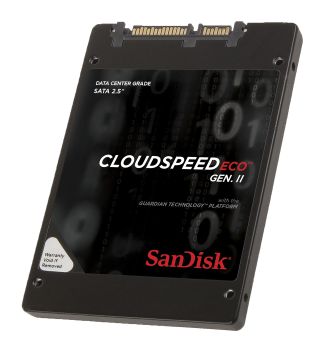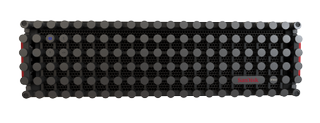WD-SanDisk Merger Approved, Finalizes May 12

Western Digital announced the $19 billion SanDisk acquisition in October 2015 and that its shareholders approved the acquisition in March 2016, which left MOFCOM (the Chinese Ministry of Commerce) approval as the only remaining barrier to the merger. WD announced today that it has received regulatory approval from MOFCOM to proceed, and the transaction closes on May 12--a scant two days away.
SanDisk is one of the early leaders of NAND development and holds over 5,000 patents, but broader management issues led to a dramatic weakening of the company's prospects last year. The resultant crash of SanDisk's stock price opened the door for WD to step in and purchase the company.
Portfolios Come Crashing Together
WD/HGST has a strong presence in enterprise SSDs, but there is nearly nothing of substance on the client SSD side. The company has its WD Black dual drives, which are a sandwiched SSD and HDD that operate separately, and its WD Blue SSHD. The SSHD is a valiant effort to claim space in the notebook segment, but frankly, SSHDs are not catching on for either Seagate or WD.
The SanDisk acquisition allows WD/HGST to hit the ground running with consumer SSDs. The SanDisk portfolio includes the successful Extreme series SSDs, which continue to top our Best SSDs rankings in the performance segment.
The addition of the SanDisk arsenal to WD's war chest creates a ferocious competitor with a portfolio stocked to the point of overflowing. SanDisk amassed IP through a string of acquisitions that included Pliant, Schooner, SMART Storage Systems and Fusion-io to gain access to the lucrative enterprise segment. The acquisitions spawned a full portfolio that spans from microSD cards up to the latest bleeding-edge enterprise-class storage systems.
WD is no stranger to flash on the enterprise side; it has a well-rounded portfolio because of its own acquisitions that included Virident, STEC, Amplidata and Skyera. WD has placed all of these assets under the HGST umbrella, but with the recent finalization of that acquisition, the two companies are effectively now one and the same. HGST has been vocal that it is transitioning to a systems provider, which began with its Active Archival system, and the SanDisk InfiniFlash makes a nice bookend product for the high-performance segment.
WD will have to sort out some overlaps on the enterprise side, but the real strategic win is the immediate ability to fabricate its own flash, and thus enhance its profitability and competitiveness. HGST already has a strategic alliance with Intel for flash used in its SAS SSDs, but that likely will not last long as WD transitions to SanDisk flash.
Stay on the Cutting Edge
Join the experts who read Tom's Hardware for the inside track on enthusiast PC tech news — and have for over 25 years. We'll send breaking news and in-depth reviews of CPUs, GPUs, AI, maker hardware and more straight to your inbox.
Potential Obstacles

SanDisk purchased a number of companies over the last few years, but it does not have a history of quickly integrating them. Many assume this is the result of culture clashes.
People are always the wild card in any integration process, and WD's ability to absorb the large far-flung SanDisk machine into its own massive operation will be of the utmost importance. WD and HGST still have to maintain separate product stacks for the next two years, but are allowed to share technology--which means we could see some interesting product placements.
Oddly, WD already purchased both STEC and Virident, which both have their own PCIe SSD offerings. The company continues to maintain two separate product lines in that respect, but three will make a crowd as SanDisk brings Fusion-io (once the darling of the PCIe SSD industry) into the fold. There are also serious overlaps in the bread-and-butter enterprise SAS and SATA segments that will likely take some time to untangle.
In either case, there will inevitably be severe workforce cuts as the company removes redundancies. Reconciling the product overlaps will also magnify the human impact, even in the C-Suite, and there will likely be large headcount reductions in R&D and sales categories, among others. There will likely be limited plant closures (if any) because the two companies manufacture inherently dissimilar products.
The Impact To Seagate
WD, like Seagate, is dealing with a declining desktop PC market that contracted 10.6 percent in 2015 and is predicted to continue to decline in 2016.
In contrast, WD has a winning formula to retake share by transitioning to SSDs and flash. SSDs also are not a high-margin product on the client side, especially in light of a current glut of NAND, but the high-margin enterprise segment will prove to be a lucrative prospect. WD will likely engage in cutthroat SSD pricing for OEM notebooks, which will have the strategic impact of reducing Seagate's already-dismal market share in that segment, and it also clears it to become more aggressive in the desktop segment.
Some of this success will come at its own expense. One SSD can replace 8-15 enterprise HDDs (depending upon the workload), but strategically it is better to cannibalize your own sales than allow another to do it.
Seagate is struggling. The company inked a strategic alliance with Micron to share technology and gain guaranteed access to flash, but this is not enough to weather the intense HDD storms that have seen its market cap fall from $10.39 billion to $5.72 billion in a matter of weeks. Seagate will likely need NAND fabrication capability to compete with WD, but in an odd twist of fate, its recent travails find it with a negative credit rating from Moody's, among others.
Seagate's dire credit outlook reduces its ability to pursue a strategic acquisition of a NAND fab in the near term, but its low stock price would make it a wonderful acquisition target for a large fab such as Micron. Seagate will need to take bold action, or have another take bold action against it, to be competitive with WD in the future.
To The Future With Flash
The SanDisk acquisition brings the WD development effort full circle and clears the way for it to transition to a systems provider and flash powerhouse. (Make no mistake, that is the end game for WD/HGST.) The acquisition will allow WD to upsell and cross-sell with both new and existing customers. It also serves as a new tool that WD can use to pry Seagate out of other segments.
Seagate finds itself on the outside looking in, at least for now.
Paul Alcorn is a Contributing Editor for Tom's Hardware, covering Storage. Follow him on Twitter and Google+.
Follow us @tomshardware, on Facebook and on Google+.
Edit: 5/10/16 9PM CST - fixed grammatical error.

Paul Alcorn is the Managing Editor: News and Emerging Tech for Tom's Hardware US. He also writes news and reviews on CPUs, storage, and enterprise hardware.
-
joz I see nothing wrong with WD Branded Flash DrivesReply
Been happy with my last decades of HD purchases from WD (black, and blue drives only.)
-
PaulyAlcorn ReplyI see nothing wrong with WD Branded Flash Drives
I agree that there is nothing wrong with WD flash products, but the imaginative dual SSD/HDD drive is not going to gain much market share, let alone when compared to the heft of the SanDisk product stack. It's SSHDs are also nice, but the price of NAND has fallen fast enough that these "inbetweeners" are no longer enough to make a meaningful impact, which would ensure economies of scale (and sales) that churn hefty margins.
Been happy with my last decades of HD purchases from WD (black, and blue drives only.)
WD made the right decision, and now there is definitely nothing wrong with their product stack - they have an SSD for every day of the month :) This does raise the question of how they will brand them, though. Will the SanDisk name live on?
-
ubercake A great SSD company merging with a great HDD company. Both make reliable top-notch products.Reply
I was wondering what WD was going to do to stay relevant as the market continues to move away from mechanical drives. Now I have my answer. -
captaincharisma ReplyThe plural of portfolio is portfolios. No apostrophe.
ok, settle down grammar nazi
-
JonnyDough I hope China has a better agency than our FTC, that actually does their job instead of allowing monopolies to be created.Reply -
JonnyDough I hope China has a better agency than our FTC, that actually does their job instead of allowing monopolies to be created.Reply -
nowendoc ReplyThe plural of portfolio is portfolios. No apostrophe.
Yes! Keep Tom's standard up please.
-
jt AJ Reply
i can only see intel and samsung destroy wd/sandisk in the high margin enterprise market. unless of course sandisk can be competitive in power saving as well as endurance and performance, and pricing.
Most Popular


